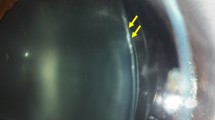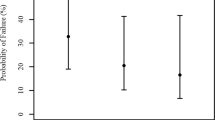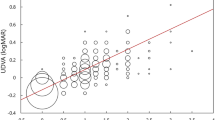Abstract
Objectives
To identify factors associated with progressive anisometropia after bilateral intraocular lens (IOL) implantation in patients with pediatric cataract.
Methods
Clinical and standardized questionnaire data were collected for Sixty-eight patients with pediatric cataract (136 eyes) who underwent bilateral IOL implantation and at least 1 year of follow-up. Univariate and multivariate linear regression models were used to identify factors associated with postoperative anisometropia.
Results
The median age at IOL implantation was 3.2 years (range: 1–12.4 years), and median follow-up time was 5.7 years (range: 1.1–14 years). At 1 month postoperatively and at the last follow-up, there were 19 (27%) and 31 (46%) cases of anisometropia ≥1 D, 9 (13%) and 15 (22%) cases of anisometropia ≥2 D, and 2 (3%) and 9 (13%) cases of anisometropia ≥3 D, respectively. Compared with 1 month postoperatively, the amount of anisometropia increased in 45 (67%) patients. Greater anisometropia one year or more after bilateral IOL implantation was associated with larger intereye difference in IOL power (P = 0.032, 95%CI 0.013 to 0.285), intereye difference in preoperative axial length (P = 0.018, 95%CI –1.247 to –0.123), presence of strabismus (P = 0.017, 95%CI 0.063–0.601), anisometropia at 1 month postoperatively (P = 0.001, 95%CI 0.126–0.478), and intereye difference in axial length at the last follow-up (P = 0.047, 95%CI 0.005–0.627).
Conclusion
Anisometropia might progress after bilateral IOL implantation in patients with pediatric cataract. Greater intereye difference in IOL power, presence of strabismus might increase the potential of progressive anisometropia.
This is a preview of subscription content, access via your institution
Access options
Subscribe to this journal
Receive 18 print issues and online access
$259.00 per year
only $14.39 per issue
Buy this article
- Purchase on Springer Link
- Instant access to full article PDF
Prices may be subject to local taxes which are calculated during checkout


Similar content being viewed by others
Data availability
All data will be available from the corresponding author upon request.
References
Sheeladevi S, Lawrenson JG, Fielder AR, Suttle CM. Global prevalence of childhood cataract: a systematic review. Eye (Lond). 2016;30:1160–9.
Repka MX, Dean TW, Kraker RT, Bothun ED, Morrison DG, Lambert SR, et al. Visual acuity and ophthalmic outcomes in the year after cataract surgery among children younger than 13 years. JAMA Ophthalmol. 2019;137:817–24.
Brooks SE, Johnson D, Fischer N. Anisometropia and binocularity. Ophthalmology. 1996;103:1139–43.
Donahue SP. Relationship between anisometropia, patient age, and the development of amblyopia. Am J Ophthalmol. 2006;142:132–40.
South J, Gao T, Collins A, Turuwhenua J, Robertson K, Black J. Aniseikonia and anisometropia: implications for suppression and amblyopia. Clin Exp Optom. 2019;102:556–65.
Zhang XJ, Lau YH, Wang YM, Kam KW, Ip P, Yip WW, et al. Prevalence of strabismus and its risk factors among school aged children: The Hong Kong Children Eye Study. Sci Rep. 2021;11:13820.
Afsari S, Rose KA, Gole GA, Philip K, Leone JF, French A, et al. Prevalence of anisometropia and its association with refractive error and amblyopia in preschool children. Br J Ophthalmol. 2013;97:1095–9.
Deng L, Gwiazda JE. Anisometropia in children from infancy to 15 years. Invest Ophthalmol Vis Sci. 2012;53:3782–7.
Tong L, Chan YH, Gazzard G, Tan D, Saw SM. Longitudinal study of anisometropia in Singaporean school children. Invest Ophthalmol Vis Sci. 2006;47:3247–52.
Hu YY, Wu JF, Lu TL, Wu H, Sun W, Guo DD, et al. Prevalence and associations of anisometropia in children. Invest Ophthalmol Vis Sci. 2016;57:979–88.
Giordano L, Friedman DS, Repka MX, Katz J, Ibironke J, Hawes P, et al. Prevalence of refractive error among preschool children in an urban population: the Baltimore Pediatric Eye Disease Study. Ophthalmology. 2009;116:739–46.e1-4.
Weakley D, Cotsonis G, Wilson ME, Plager DA, Buckley EG, Lambert SR. Anisometropia at age 5 years after unilateral intraocular lens implantation during infancy in the infant aphakia treatment study. Am J Ophthalmol. 2017;180:1–7.
Valeina S, Heede S, Erts R, Sepetiene S, Skaistkalne E, Radecka L, et al. Factors influencing myopic shift in children after intraocular lens implantation. Eur J Ophthalmol. 2020;30:933–40.
McClatchey SK, Parks MM. Theoretic refractive changes after lens implantation in childhood. Ophthalmology. 1997;104:1744–51.
McClatchey SK, Hofmeister EM. The optics of aphakic and pseudophakic eyes in childhood. Surv Ophthalmol. 2010;55:174–82.
Smith EL 3rd, Hung LF, Arumugam B, Wensveen JM, Chino YM, Harwerth RS. Observations on the relationship between anisometropia, amblyopia and strabismus. Vis Res. 2017;134:26–42.
Lepard CW. Comparative changes in the error of refraction between fixing and amblyopic eyes during growth and development. Am J Ophthalmol. 1975;80:485–90.
Huynh SC, Wang XY, Ip J, Robaei D, Kifley A, Rose KA, et al. Prevalence and associations of anisometropia and aniso-astigmatism in a population based sample of 6 year old children. Br J Ophthalmol. 2006;90:597–601.
Wendelstein J, Hoffmann P, Hirnschall N, Fischinger IR, Mariacher S, Wingert T, et al. Project hyperopic power prediction: accuracy of 13 different concepts for intraocular lens calculation in short eyes. Br J Ophthalmol 2021;106:795–801.
Röggla V, Langenbucher A, Leydolt C, Schartmüller D, Schwarzenbacher L, Abela-Formanek C, et al. Accuracy of common IOL power formulas in 611 eyes based on axial length and corneal power ranges. Br J Ophthalmol. 2021;105:1661–5.
Tadros D, Trivedi RH, Wilson ME, Davidson JD. Ocular axial growth in pseudophakic eyes of patients operated for monocular infantile cataract: a comparison of operated and fellow eyes measured at surgery and 5 or more years later. J AAPOS. 2016;20:210–13.
Trivedi RH, Wilson ME Jr. Changes in interocular axial length after pediatric cataract surgery. J AAPOS. 2007;11:225–9.
Tong L, Saw SM, Chia KS, Tan D. Anisometropia in Singapore school children. Am J Ophthalmol. 2004;137:474–9.
Wilson ME Jr, Trivedi RH. Eye growth after pediatric cataract surgery. Am J Ophthalmol. 2004;138:1039–40.
Lin H, Lin D, Chen J, Luo L, Lin Z, Wu X, et al. Distribution of axial length before cataract surgery in Chinese pediatric patients. Sci Rep. 2016;6:23862.
Fledelius HC, Goldschmidt E, Haargaard B, Jensen H. Human parallels to experimental myopia? A literature review on visual deprivation. Acta Ophthalmol. 2014;92:724–9.
Thomson K, Karouta C, Ashby R. Form-deprivation and lens-induced myopia are similarly affected by pharmacological manipulation of the dopaminergic system in chicks. Invest Ophthalmol Vis Sci. 2020;61:4.
Funding
This study was supported by the National Natural Science Foundation of China (No. 81670840; No.82000874). The funding organizations had no role in the design or conduct of this research.
Author information
Authors and Affiliations
Contributions
El and LL was responsible for conceptualization, methodology, investigation, analysis and interpretation of data, writing–original draft preparation, writing–reviewing and editing. MZ was responsible for investigation, critical revision of the academic content of the manuscript. JL and MZ was responsible for methodology. KZ contributed to investigation. EM and JX contributed to formal analysis. Y-eZ and JL was responsible for conceptualization, writing–reviewing and editing, funding support.
Corresponding authors
Ethics declarations
Competing interests
The authors declare no competing interests.
Additional information
Publisher’s note Springer Nature remains neutral with regard to jurisdictional claims in published maps and institutional affiliations.
Rights and permissions
Springer Nature or its licensor (e.g. a society or other partner) holds exclusive rights to this article under a publishing agreement with the author(s) or other rightsholder(s); author self-archiving of the accepted manuscript version of this article is solely governed by the terms of such publishing agreement and applicable law.
About this article
Cite this article
liu, E., Lin, L., Zhang, M. et al. Factors associated with progressive anisometropia after bilateral intraocular lens implantation in patients with pediatric cataract. Eye 38, 594–599 (2024). https://doi.org/10.1038/s41433-023-02740-4
Received:
Revised:
Accepted:
Published:
Issue Date:
DOI: https://doi.org/10.1038/s41433-023-02740-4



